Supermarket Meat Department
On this page
- What kind of work is done in the meat department of a supermarket?
- What are some health and safety hazards for supermarket meat department workers?
- What are some preventive measures for supermarket meat department workers?
- Supermarket Meat Department: WMSD Prevention Case Study
- What are the tasks involved in Meat Cutting?
- What are the risk factors when Meat Cutting?
- What are the tasks involved in Meat Packaging?
- What are the risk factors when Meat Packaging?
- What are the tasks involved in Meat Wrapping?
- What are the risk factors when Meat Wrapping?
- How can we reduce the risk factors for WMSD?
What kind of work is done in the meat department of a supermarket?
Back to topThere are a variety of activities in the meat department of a supermarket. Three of them are:
- meat cutting
- meat packaging
- meat wrapping
These activities were selected for the physical effort they require and the health hazards they pose.
Meat processing requires a specific thermal condition; the ambient temperature is to be kept between +10°C to +11°C. This is far below the comfort zone for people. The temperature at which the meat is stored is even lower at about +5°C.
What are some health and safety hazards for supermarket meat department workers?
Back to top- Working with machinery such as meat slicers, cardboard baler, etc.
- Working with sharps (knives, box cutters).
- Manual Material Handling.
- Slips, trips, and falls.
- Exposure to cold environments.
- Stress.
- Working alone, including working along with money.
- Dealing with difficult or potentially violent customers.
In addition to some of the hazards listed above, pain or injury from physical overexertion, repetitive manual tasks, or working in awkward positions is very common. A case study is presented below.
What are some preventive measures for supermarket meat department workers?
Back to top- Scan the workplace for existing and potential hazards before work begins and take appropriate controls. Be aware that conditions can change constantly.
- Inspect all equipment and machinery for any defects before work begins.
- Keep tools and equipment in good working order.
- Use correct personal protective equipment and apparel, including safety footwear.
- Keep all work areas clear of clutter and equipment.
- Practice good housekeeping.
- Avoid awkward body positions or take frequent breaks.
- Learn safe lifting techniques.
- Take and understand any education or training before beginning any task.
- Know how to get help in an emergency for working alone situations or when dealing with a potentially violent customer.
- Be aware of the emergency response plans before work begins.
- Know how to report a hazard.
- Stay informed about chemical hazards and WHMIS 2015.
Supermarket Meat Department: WMSD Prevention Case Study
Back to topThe following case study reviews the activities found in a meat department of a supermarket and associated ergonomics risk factors for work-related musculoskeletal disorders (WMSDs).
What are the tasks involved in Meat Cutting?
Back to topThe cutting of meat occurs mostly during the night shift and involves:
- carrying a box of meat from the storage area to the worktable
- cutting the meat into big pieces
- removing fat
- slicing pieces of meat
The cutting requires the use of both hands. One hand is used to hold the piece of meat, while the other hand operates the knife (Figure 1). The cutting is done while standing.
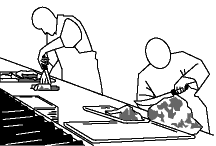
Figure 1 - Cutting the meat
What are the risk factors when Meat Cutting?
Back to topAwkward body positions and forceful movements are the risk factors for the neck and shoulders and other upper limb injuries. In this supermarket, a non-adjustable work surface causes workers to use poor working postures. The Ergonomics section in OSH Answers has more information on Work-related Musculoskeletal Disorders (WMSDs) risk factors.
Aggravating factors for WMSDs are the low room temperature and the temperature of the meat. Cold affects dexterity and increases the effort needed. This extra effort can cause earlier fatigue.
In addition, lifting heavy boxes and prolonged standing on a hard floor pose a risk for low back pain and lower leg discomfort.
All of these factors have a compounding effect; in other words, each of them increases the effect of the others.
What are the tasks involved in Meat Packaging?
Back to topIn the meat packaging department, colour-coded expanded polystyrene (e.g. Styrofoam plates) are filled with pork, beef and poultry. Workers carry the meat to be processed from the storage room to the work bench. They also arrange the plates, add moisture absorbing sheets, and place aluminum trays on the work bench (Figure 2).
To complete a task a worker has to:
- Pick up a colour-coded plate.
- Pick up a moisture-absorbing sheet.
- Grasp pieces of meat from a box.
- Fill the plate.
- Remove the plate from the bench.
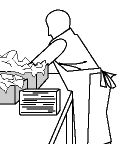
Figure 2 - Packaging the meat
What are the risk factors when Meat Packaging?
Back to topIn this supermarket, the work surfaces that were too low or high and improperly arranged work areas caused workers to use poor working postures. Prolonged, stooped standing posture, repetitious bending (Figure 3), stretching and reaching beyond the comfort ranges put a strain on the neck and shoulders, upper limbs and back which can result in injury.
The low temperatures and contact with cold meat also contribute to the development of injuries.
Working while standing on a hard floor can cause lower leg aches and low back pain which over time can develop into injuries.
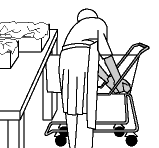
Figure 3 - Reaching for a plate
What are the tasks involved in Meat Wrapping?
Back to topThe meat wrapping operation requires a continual repetition of movements. To complete a task, a worker has to:
- Pick up a plate (Figure 4).
- Wrap the plate (Figure 5).
- Seal the plate (Figure 6).
- Label the plate (Figure 7).
- Store the plate (Figure 8).
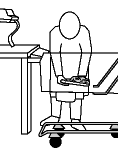
Figure 4 - Picking up a plate
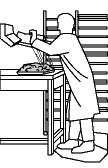
Figure 5 - Wrapping the plate
One task lasts between 10 and 20 seconds. The time to complete the task varies according to the wrapper's skills and whether there is a double wrapping and sealing.
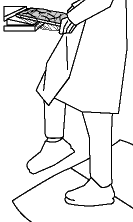
Figure 6 - Sealing the plate
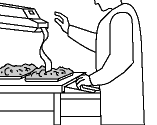
Figure 7 - Labelling the plate
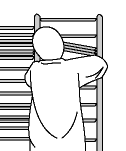
Figure 8 - Storing the plate
What are the risk factors when Meat Wrapping?
Back to topHighly repetitive movements required in the wrapping of meat, combined with standing for long periods in an awkward position pose risks for repetitive motion injuries.
The wrapper's wrists are at a high risk for injury from frequent manipulative movements while wrapping, sealing and labelling. An aggravating factor to wrist injury is that each of these three tasks is carried out at a different height with reaches beyond recommended ranges. Frequent and forceful movements of the wrists require considerable and sustained muscular effort of the neck and shoulders.
Prolonged standing in a stooped position and repetitious side motions can contribute to low back injuries, and standing on a concrete floor can contribute to lower leg and back discomfort that over time can develop into injuries.
How can we reduce the risk factors for WMSD?
Back to topGeneral Recommendation
Working in the meat department of a supermarket exposes workers to hazards for various musculoskeletal problems.
Workers in the meat department should rotate between the cutting, packaging and wrapping operations. The rotation is beneficial because it makes workers change body positions and use different parts of their bodies.
Meat Cutting
Awkward body postures and movements, along with considerable force exerted repeatedly while cutting are major risk factors for injuries among meat cutters.
Work postures can be improved greatly by providing meat cutters with adjustable work surfaces (Figure 9). There are a few options to consider:
- work platforms for shorter workers
- tables with fully adjustable surfaces
- a variety of worktables of different heights
4.gif)
Figure 9 - Adjustable work surfaces
The height of the work surface should be adjusted to the workers' individual needs and according to the task performed. Cutting large chunks of meat requires a lower work surface (65-95 cm) while fine cutting requires a higher work surface (85-110 cm). Cutting in a position beyond the comfort zone requires more force.
In addition, meat cutters' gloves that fit properly can reduce:
- the effort needed to hold the meat: they also improve the grip on slippery meat
- the undesirable effects of contact with cold meat
- the hazards for cuts; this eases muscular tension
Selecting and maintaining proper knives can also reduce the need to exert force in the meat cutter's task (Figure 10).
1.gif)
Figure 10 - Knife handles that eliminate bending the wrist while cutting
Repetitiveness seems to be an integral part of meat cutting. To reduce its undesirable effects, re-designing the meat cutting job should be considered. Possible option is job rotation. Job rotation requires workers to move between different tasks at fixed or irregular periods of time. It increases the variety of tasks and involves more autonomy and control for the worker.
Workers should use anti-fatigue matting to reduce stress on the legs and back due to prolonged standing on a hard floor and footrests to encourage changes in body position where possible.
Meat Packaging
Major hazards in the meat packaging operation result from awkward body positions. To reduce these awkward postures, it is necessary to design the height of the work bench for the tallest worker and according to the task. Short workers should use a work platform. The work bench should have a footrest.
It is also necessary to re-arrange the layout of the work materials. To avoid twisting, the work materials should be within easy reach, arranged in a semi-circle or L-shape (Figure 11).
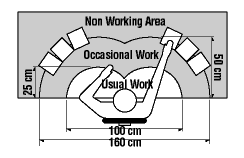
Figure 11 - Arranging work in a semi-circle
To reduce bending the wrist when grasping the meat from the box, it is necessary to cut one wall of the box (Fig. 12).
To reduce bending, place the packaged meat on a lifting table on wheels. Lift tables can be raised and lowered pneumatically with a pump powered by battery or electricity or a pump operated by hand or foot. To reduce twisting, make sure that the lifting table is beside and not behind the worker. The use of a sit/stand stool should be considered for the packaging operation. Workers should use gloves because of the low temperatures. Workers should also use anti-fatigue matting to reduce stress on the legs and back due to prolonged standing on a hard floor.
3.gif)
Figure 12 - Cutting one wall of the box eliminates bending the wrist
Meat Wrapping
The major hazards in the meat wrapping operation result from awkward body postures that workers use because of the poor design of the wrapping machine. Ideally, wrapping, sealing and labelling should be done at the same height and within easy reach. This solution would require a complete re-design of the wrapping machine.
However, some improvements can be achieved with minor changes.
For example, lifting tables on wheels or meat bins on wheels with an elevating and rotating device could be used. These changes can minimize bending and stretching to pick up packages for wrapping and to store the packages (Figure 13).
The use of anti-fatigue matting will reduce stress on the legs and back due to prolonged standing on a hard floor.
2.gif)
Figure 13 - A lift table
Acknowledgement
The Canadian Centre for Occupational Health and Safety in co-operation with the Government of Newfoundland and Labrador, Department of Employment and Labour Relations, Occupational Health and Safety Branch would like to acknowledge the participation of Sobeys Ropewalk Lane (A Division of Sobeys Stores) who so freely gave their time and resources to assist us in the development of this case study.
- Fact sheet last revised: 2021-03-23
